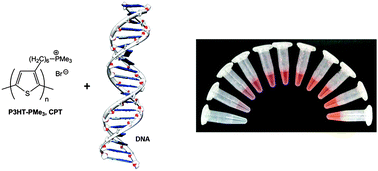The combination of DNA and π-conjugated polyelectrolytes (CPEs) represents a promising approach to develop DNA hybridization biosensors, with potential applications for instance in the detection of DNA lesions and single-nucleotide polymorphisms. Here we exploit the remarkable optical properties of a cationic poly[3-(6′-(trimethylphosphonium)hexyl)thiophene-2,5-diyl] (CPT) to decipher the self-assembly of DNA and CPT. The ssDNA/CPT complexes have chiroptical signatures in the CPT absorption region that are strongly dependent on the DNA sequence, which we relate to differences in supramolecular interactions between the thiophene monomers and the various nucleobases. By studying DNA–DNA hybridization and melting processes on preformed ssDNA/CPT complexes, we observe sequence-dependent mechanisms that can yield DNA-condensed aggregates. Heating–cooling cycles show that non-equilibrium mixtures can form, noticeably depending on the working sequence of the hybridization experiment. These results are of high importance for the use of π-conjugated polyelectrolytes in DNA hybridization biosensors and in polyplexes.

